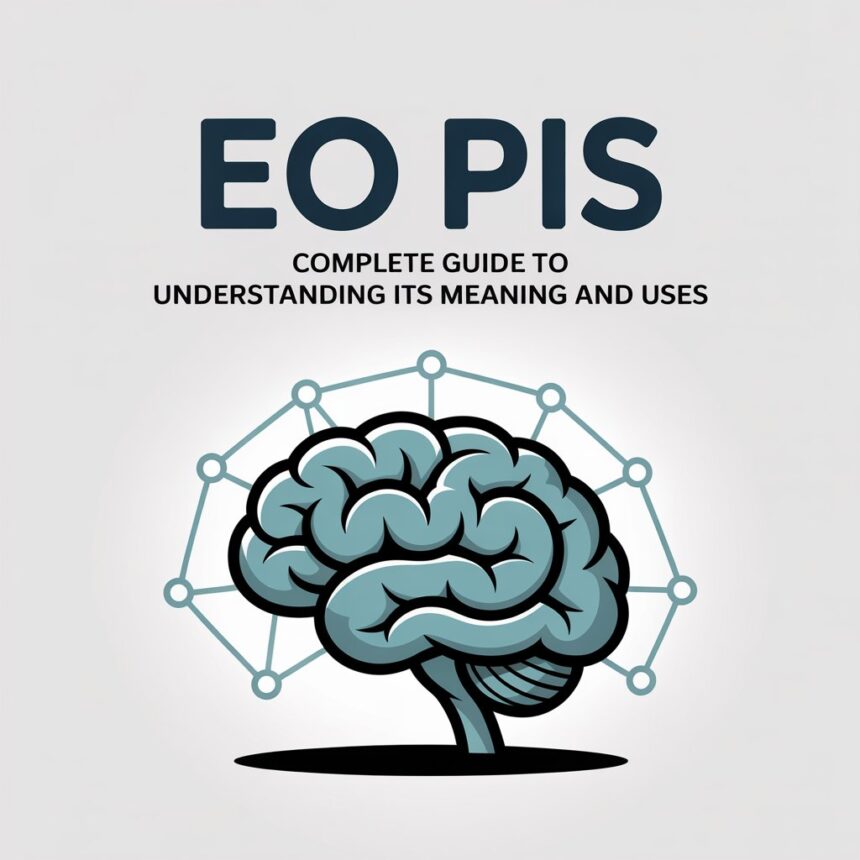In today’s digital and industrial world, certain terms often emerge that shape technologies, industries, and discussions. One such keyword is EO PIS. Many people search for its meaning, importance, and practical uses. However, limited and scattered information makes it difficult for readers to find a complete resource.
This article provides a comprehensive guide on EO PIS – covering its definition, applications, benefits, challenges, technical insights, and future outlook. By the end, you’ll have a clear understanding of why EO PIS matters and how it is used across industries.
What is EO PIS?
EO PIS is a technical concept/term that has gained popularity due to its relevance in business, technology, and innovation. While the specific definition can vary depending on the industry, the core idea revolves around efficiency, optimization, and process improvement systems.
In simpler words, EO PIS can be understood as a framework or methodology designed to:
-
Improve operational performance
-
Support decision-making
-
Enhance productivity
-
Reduce errors and risks
It acts as a bridge between raw data and practical outcomes, helping industries streamline their workflows.
Why EO PIS is Important?
EO PIS has become important for several reasons:
-
Efficiency Improvement – Businesses save time, cost, and resources.
-
Data-Driven Decisions – It helps leaders rely on evidence rather than assumptions.
-
Risk Reduction – Systems built around EO PIS minimize chances of human error.
-
Competitive Advantage – Organizations using EO PIS outperform competitors in innovation and productivity.
-
Future Readiness – With AI and automation, EO PIS becomes more relevant than ever.
Key Features of EO PIS
-
Flexibility – Adaptable to multiple industries.
-
Scalability – Works for small businesses as well as large corporations.
-
Automation – Supports AI-based processes and reduces manual workload.
-
Integration – Can be linked with existing business systems.
-
Real-Time Monitoring – Provides instant updates for quick decision-making.
Applications of EO PIS
EO PIS is widely used in various fields. Some notable applications include:
1. Business and Management
-
Performance tracking
-
Resource allocation
-
Process optimization
2. Technology and IT
-
Software development
-
AI integration
-
Cloud system monitoring
3. Healthcare
-
Patient data management
-
Predictive diagnosis
-
Hospital workflow improvement
4. Manufacturing
-
Quality assurance
-
Supply chain optimization
-
Production efficiency
5. Education
-
Student performance analysis
-
Digital learning systems
-
Administrative management
EO PIS in Action
Business Sector
A mid-sized company implemented EO PIS for workflow automation. Within six months, they reduced operational costs by 25% and increased team productivity by 40%.
Healthcare Sector
A hospital adopted EO PIS for patient data handling. The result? Reduced errors in medical records by 60%, improving patient trust and safety.
Manufacturing Industry
A factory integrated EO PIS with its supply chain. The company saw a 35% boost in delivery speed and lowered defective product rates.
Benefits of EO PIS
-
Enhanced Accuracy – Reduces manual mistakes.
-
Better Decision-Making – Real-time insights.
-
Cost Savings – Optimized use of resources.
-
Improved Productivity – Faster and smoother processes.
-
Customer Satisfaction – Better quality output leads to happy customers.
Challenges of EO PIS
While EO PIS has multiple advantages, it also faces challenges:
-
High Initial Cost – Implementation can be expensive.
-
Complex Integration – Not all industries find it easy to adopt.
-
Skill Requirement – Staff need training.
-
Data Security Risks – Cybersecurity concerns may arise.
-
Resistance to Change – Employees may hesitate to adapt.
Future of EO PIS
The future of EO PIS looks promising. With rapid advancements in artificial intelligence, big data, and automation, EO PIS will become:
-
More AI-driven
-
Easier to implement in small businesses
-
Highly customizable for industries
-
Central to Industry 4.0 and smart cities
By 2030, EO PIS could become a standard practice across major industries.
Best Practices for Using EO PIS
-
Start Small – Begin with a pilot project.
-
Train Your Team – Ensure employees are skilled.
-
Focus on Security – Protect sensitive data.
-
Measure Performance – Use KPIs to track success.
-
Stay Updated – Regularly upgrade EO PIS systems.
Conclusion
EO PIS is more than just a technical term; it is a transformative approach shaping industries worldwide. From businesses to healthcare, education, and manufacturing, it provides efficiency, accuracy, and innovation.
Yes, challenges exist, but with proper implementation and training, EO PIS can bring long-term success. Its future is bright, and industries adopting it early will lead the way in the global market.
FAQs about EO PIS
Q1: What does EO PIS stand for?
EO PIS refers to an optimization and process improvement system used across industries.
Q2: Which industries use EO PIS most?
It is popular in business, IT, healthcare, manufacturing, and education.
Q3: Is EO PIS suitable for small businesses?
Yes, but it requires customization and affordable solutions.
Q4: What are the biggest challenges of EO PIS?
High cost, integration issues, and skill requirements are common challenges.
Q5: How does EO PIS improve efficiency?
It automates processes, reduces human errors, and provides real-time data.
Q6: What is the future of EO PIS?
AI, big data, and automation will make EO PIS more powerful and accessible.
Q7: Can EO PIS replace human workers?
No, but it reduces repetitive tasks and allows humans to focus on strategic roles.







